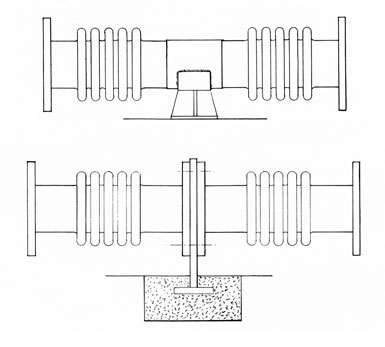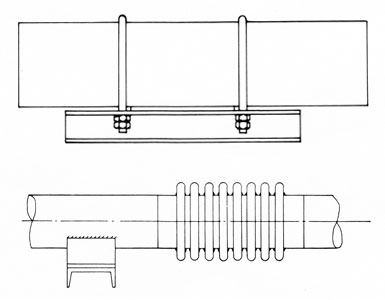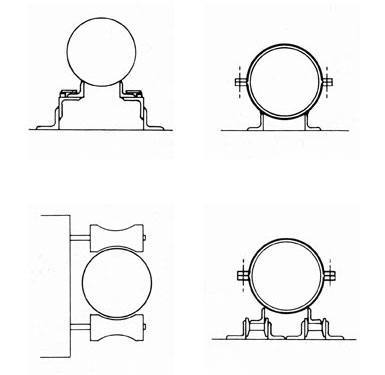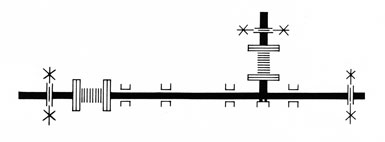Installation Requirements
Main anchors by definition are installed where directional changes take place, at the end of a line or between expansion joints of different size. They have to carry the full pressure thrust, the spring forces, and the frictional forces due to alignment guides and supports, and in some cases, the weight of piping, fittings and contents.

The design of such anchors is therefore, beyond the scope of the design engineer, unless full details of the entire structure are provided. In these cases, anchors may be furnished as an integral part of the expansion joint.

An intermediate anchor divides a pipe system into an individual expanding section, and is only responsible for the forces imposed upon it by this section, i.e. it includes only for the spring forces, friction of guides and possibly the wind load and weight etc., as it effects each section of pipe. Intermediate anchors may be built into expansion unit assemblies by arrangement with the manufacturer and may lead to economies by the elimination of flanges or other fittings. Directional anchors or guides are designed to absorb loading in one direction whilst permitting motion in another. It may constitute either a main or an intermediate anchor, depending upon the application. Clearly, such guides are required to have a minimum of friction in order to reduce the loading elsewhere, and ensure its proper functioning as a guide.


Installation Instructions
The position of anchors and guides relative to expansion joints will vary with each installation and type of joint. The following is a list of basic rules for expansion joints, in accordance with E.J.M.A. (Expansion Joint Manufacturers Association),and the new British Standard Code of Practice for metallic bellows expansion joints, which provide a useful guide and will ensure a satisfactory installation.
1. Divide the pipe length into sections ensuring that the expansion of each section is within the allowable movement of a bellows joint. Locate intermediate anchors at the end of each section and main anchors at each end of the pipe run.
2. Locate expansion joints adjacent to each other and position the guides so that the first is not more than 4 pipe diameters from the expansion joint and the second not more than 14 pipe diameters from the first guide.
3. Position other guides and supports according to the piping weight, diameter and internal pressure to ensure freedom from sag or pressure deflection, refer to Data Sheet 1 (004/79/1).
4. Check that each guide is approximately 1.5 pipe diameters in length for pipes up to 8(UNIT?) diameter and approximately 12(UNIT?) long for larger sizes. Some approved designs are illustrated.
5. Never use more than one expansion joint between two anchors, unless they form part of a expansion joint assembly, such as an articulated joint and have been supplied with full knowledge of the pipe layout.
6. Thermosel© expansion joints may be cold drawn from their neutral position by up to half the total rated expansion. Data Sheet 1 (004/79/1) provides for installation at different ambient temperatures.
7. Pipe anchors should be located at changes in pipe direction, or whenever necessary to divide straight lengths to suit maximum expansion joint movement. Joints should be at least 4 pipe diameters from dampers, gate valves, butterfly valves or other accessories.
8. Expansion joints should never be used to correct pipe alignment or fitting errors beyond the design parameters of the joint. Torsional strain for example is not permitted and flange holes must therefore be carefully aligned.
9. When internal sleeves are fitted, directional flow arrows indicate the correct way to install the unit with respect to the actual direction of flow.
10. Shipping restraints (painted red) when supplied, maintain the overall length of the assembly for shipment. These devices may also be used to pre-compress, pre-extend or laterally offset the bellows, to commissioning.
11. The convolutions of stainless steel expansion joints must be protected from weld splatter. Foreign material entering the space between the convolutions, either internally or externally, will prevent correct operation of the joint and may result in premature failure.
12. Standard expansion joints are pressure tested prior to despatch to 1.5 times the operating pressure, and pipework should not be tested in excess of this. Testing should not be carried out until the anchors are secure and the pipework correctly guided.
13. Where a gaseous system is to be hydraulically tested, determine whether the piping and bellows joints require additional temporary support to carry the weight of water to be used during the test.
14. Main anchors must be designed to withstand the highest combined effects of pressure thrust, spring rate force and the friction force generated by guides. See Data Sheet 4 (007/79/1).
15. Insulation materials containing sulphides, chlorides or other contaminates must not be used on stainless steel expansion joints and must not be allowed to fall between the convolutions. Aluminium, lead or zinc bearing paints, must not be used on stainless steels.